- View
- History & Places of Interest
- Sightseeing
- Experience
- History & Places of Interest
- Nature/Scenic Spots
-
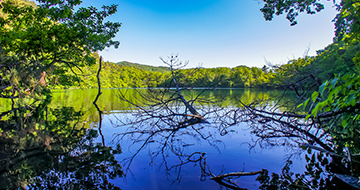 Folklore
FolkloreSankyo no Ike
Sankyo no Ike is located closed to Komyobutsuji Temple, where a buddhist monk Tanzei Shonin stayed for six years, located at upper stream from the Masaragawa area, 340m up in the mountain. The circumference of the lake surrounded by a thick bunch of trees is 500m. You can walk around the lake along a promenade. A legendary tragic love story of the male dragon, the master of the lake, and a beautiful girl named Osen has been retold from generation to generation. The stream of Ozare River, fed by water of this Sankyo no Ike, becomes Waterfall of Ozare, to flow into the sea around the Masaragawa area in Sotokaifu.
Ryotsu area -
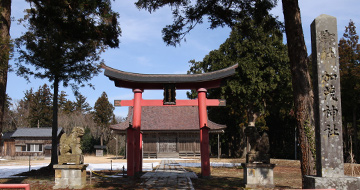 Noh Stages
Noh StagesKamo Shrine Noh Stage
Kamo Shrine was established after Yoshitsuna Minamoto (also known as Jiro Kamo) was exiled to Sado in 1109, by dividing and re-enshrining the gods of Kamo Shrine in the ancient capital city of Kyoto, where he had his coming-of-age ceremony. Transferred from the original location to where it stands now, the shrine buildings were reconstructed in 1694. This shrine considers fowls to be divine messengers, so the buildings have wood-carved nosings shaped like fowl and votive panels with a fowl motif which are dedicated to the shrine, including the Giant Fowl Votive Panel (a City Designated Tangible Cultural Property). At the back of the shrine, there is a free-standing Noh stage representing Sado. The Noh stage at Kamo Shrine is one of the Four Noh Stages in the Kuninaka Area, four prestigious Noh stages where performances were regularly held, including the one at Nyakuichioji Shrine (Sawata Nakahara), Daizen Shrine (Mano Takeda), and Ushio Shrine (Niibo Katagami). Evening Noh performances are held annually in August.
Kuninaka area -
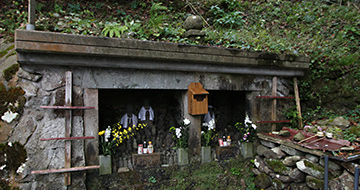 Heritage and Relics Folklore
Heritage and Relics FolkloreMearai Jizo (Eye Washing Statue of Bodhisattva)
The story of "Sansho-Dayu" is famous for the tale of Anju and Zushio. In it, the grown-up Zushio and his blind mother are reunited, and rejoice over finding the other in good health ("tassha" in Japanese) at Tassha Coast in Sado. Water still bubbles up at the place where the mother washed her eyes, and Mearai Jizo is enshrined there. Anju Jizo Hall stands nearby, where a bath with the spring water has been set up by locals and is available for use.
Aikawa area -
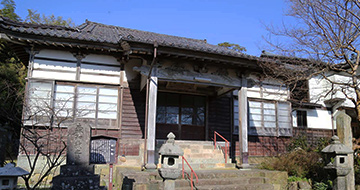 Shrines and Buddhist Temples
Shrines and Buddhist TemplesDaianji Temple
Daianji was established in 1606 by Nagayasu Okubo, the first Commissioner of Sado. A long, beautifully cobbled path leads up to the Sanmon gate, and the main hall features the temple crest of three leaves of hollyhock in a circle. The temple houses a memorial tower built by Nagayasu Okubo prior to his death, and a memorial tower for Hikozaemon Kawamura who was involved in the early-stage development of the Sado gold and silver mines. Both towers are National Historic Sites. This temple also holds the burial grounds for officials who served the Sado Commissioner's Office. A spectacular Machilus thunbergii (bay tree) grove, a Sado Natural Monument, stands behind the graveyard. Drastic urbanization due to the development of the mines significantly changed the landscape of the Aikawa area. Still, groves within the grounds of temples and shrines retain their native vegetation. Many plants such as the giant Machilus thunbergii, camellia and Euonymus japonicus (Japanese spindle) grow in the dense natural woodland of Daianji Temple.
Aikawa area -
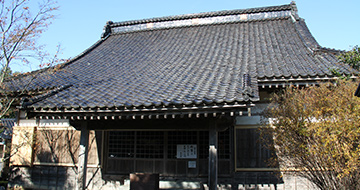 Shrines and Buddhist Temples
Shrines and Buddhist TemplesHonkoji (in Miyakawa)
Honkoji Temple in Miyakawa was established by Nichigyo Shonin, with Nichiro Shonin as the first head priest. Within the precinct, you can see relics closely related to Nichiren (exiled founder of the Nichiren School of Buddhism): including the "Shamen-ishi", a seating stone where Nichiren Shonin seated himself when his lead disciple Nichiro Shonin delivered and revealed an amnesty letter from Kamakura; and "Kesagake no Matsu," a pine tree where Nichiren hung his monastic robe.
Kuninaka area -
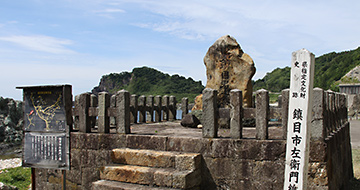 Heritage and Relics
Heritage and RelicsThe Grave of Ichizaemon Shizume
Ichizaemon Shizume is a samurai warrior of Momoyama Period to early Edo Period (1564 - 1627). He played an active role as a vassal of Ieyasu Tokugawa at the Battle of Sekigahara. (The Battle of Sekigahara is a major battle which took place near Sekigahara in 1600 between Tokugawa and Toyotomi. After this battle, Ieyasu acceded to power and established the Shogunate.) After assuming the role of Commissioner for Sado in 1618, he practised a range of policies, and gained in fame as a great commissioner who contributed to development of gold and silver mines. This grave was built in 1845 in memory of his achievement.
Aikawa area -
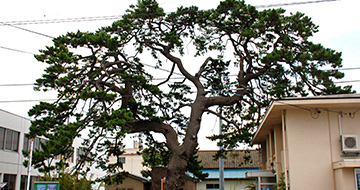 Heritage and Relics
Heritage and RelicsMurasame no Matsu (rain-showered pine)
Within the grounds of Sado Japan Coast Guard Station, a Japanese black pine tree with beautifully shaped branches stands nineteen metres tall, and has a girth of six metres. It used to be a navigational aid for maritime pilots at sea, and is mentioned in the folk song, "Ryotsu Jinku". Murasame no Matsu used to be called "Otabisho no Matsu" (a pine tree at the midway resting point of a god during a procession), or "Gobansho no Matsu" (a pine tree at a port observation post). Koyo Ozaki, a novelist who visited Sado in the Meiji times (1868-1912), thought the tree getting splashed by waves resembled the wetness of getting caught in a shower of rain (called "murasame" in Japanese). The tree's name is derived from this episode. Murasame no Matsu is a Niigata Prefecture Natural Monument.
Ryotsu area -
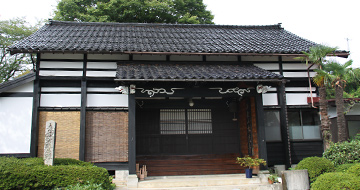 Shrines and Buddhist Temples
Shrines and Buddhist TemplesHonkoji Temple (in Izumi)
Honkoji was founded in 1310 by a Buddhist monk Nissho Shonin, who became a strong believer of Nikko Shonin. It sits in the neibourhood of the ruins of Kuroki Palace, where Emperor Juntoku used to live. The temple treasures a wood-carved standing statue of Seikannon (Goddess of Mercy), a designated National Important Cultural Property, which is one of the four statues that Emperor Juntoku brought with him from Kyoto. The temple also has a Mandala (Sado City's designated Tangible Cultural Asset) drawn by Nikko Shonin, who was a leading disciple of Nichiren Shonin (founder of Nichiren School of Buddhism exiled to Sado).
Kuninaka area -
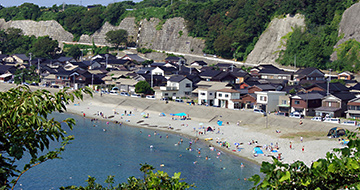 Folklore
FolkloreTassha Coast
There is a heartbreaking story called "Sanshodayu", which tells a story of maternal separation of Anju and Zushio. Tassha Coast is where grown-up Zushio and blind mother see each again and took pleasure in finding each other in good condition (tassha in Japanese). Eye washing jizo statue, which enshrines spring water which healed mother's eyes, are carefully looked after by local people. Tassha Coast, located at a corner of scenic spot Senkakuwan Bay, forms a quiet inlet and has become Sado's representative bathing beach.
Aikawa area -
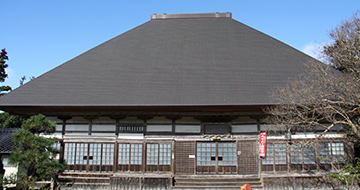 Shrines and Buddhist Temples
Shrines and Buddhist TemplesKeikuji Temple
Keikuji Temple is a temple of the Shingon School (founded in 807) with Dainichi Nyorai (Mahavairocana: supreme Buddha of the Cosmos) as the main object of worship. The name of the temple "Keikuji (written as 慶宮 in Japanese) derives from the lore that Emperor Juntoku's eldest daughter, Princess Keishi (慶子), spent her life here. The Princess worshipped Fukurokuju Sonten (God of Longevity), so a master artist, Mahori Hogan Yoshitaka, donated a painting entitled "Jingo (divine protection) Fukurokuju". Keikuji Temple is one of the temples on Sado's Seven Gods of Fortune pilgrimage route. Hasso (eight patriarchs) Hall, equipped with an octagonal shrine with a rotational system, is one of a Niigata Prefecture's Tangible Cultural Assets.
Kuninaka area -
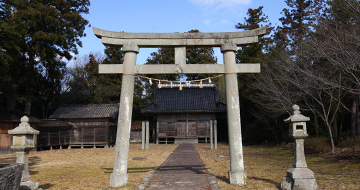 Shrines and Buddhist Temples Noh Stages
Shrines and Buddhist Temples Noh StagesSosha Shrine Noh Stage
Located in the lush greenery of the Yoshioka community, Sosha Shrine combines worship of all the deities enshrined in the nine shrines on Sado listed in the Engishiki Shrine Register, under one roof. It originally sat near the ancient provincial office of Sado (today's Danpujo castle ruins), but is said to have been transferred to where it stands now in 1307. Within the precinct, there is a Tenmangu shrine as well as a Noh stage equipped with a spacious audience area, which is thought to have been constructed around 1900. Many Noh performances have been held on this stage, which has a concave-tiled gable roof and a main entrance on the gabled side. The stage is comprised of main and rear stage areas, and the wall at the back has the traditional painting of a pine tree. The passageway connects the stage and the room behind the curtain where actors prepare. The layout of the stage facing the main hall of the shrine follows Sado's Noh stage style, and is designated a City Cultural Property. On the Annual Festival Eve, Sagiryu Kyogen performances (Prefectural Cultural Property) are offered by the Sado Sagiryu Kyogen Study Group, which is striving to pass down and spread this art form.
Kuninaka area -
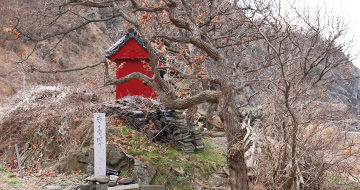 Folklore
FolkloreMemorial Mound of Anju (Anjuzuka) in Kanoura
Anju and Zushio are well-known characters who appear in the novel Sansho Dayu (Sansho the Bailiff) written by Ogai Mori. A variation of this story has been passed down on Sado, and there are some places claiming to be related to the legend. Kanoura in the Sotokaifu area is one of those places. It is said that Anju passed away here, after being reunited with her mother. Her shrine tops a small mound nestled among the rice paddies on the sea side. Look for it between the tunnels of Kanoura and Minamikatabe.
Aikawa area -
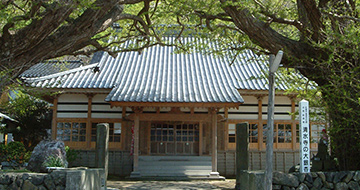 Shrines and Buddhist Temples
Shrines and Buddhist TemplesIshina Seisuiji Temple
According to the temple's book of origin, it was founded in 807. The spring bubbling up by the sanmon gate (the first gate to the temple) is the miraculous water of the inner shrine, Dantokusan, which is also the sacred mountain where monks practise mokujiki. 190 years after Mokujiki Tansei (a Buddhist monk enlightened in Sado around 1600), Mokujiki Gyodo, a nomadic monk, visited Sado in 1781-1789, and reconstructed a Buddhist hall in the area where Mokujiki Tansei practised ascetic disciplines. There, statues of Seated Yakushinyorai (Bhaisajyaguru: the Buddha of healing and medicine) and Standing Jizo (the guardian deity of children) were put up. The big ginkgo tree is Sado City's designated natural monument, and it is worshipped as a ginkgo of fertility, or a spiritual tree with healing effects for gastroenteropathy.
Aikawa area -
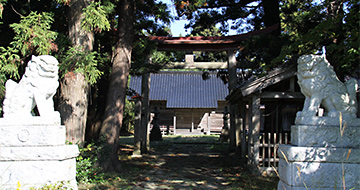 Shrines and Buddhist Temples Noh Stages
Shrines and Buddhist Temples Noh StagesTakei Kumano Shrine
Kumano Shrine is a village shrine nestled in cedar woods. Built in 1869, the Noh stage, designated a Niigata Prefectural Cultural Asset, has a hip-and-gable tiled roof in front, and a hipped roof at the back. Also, because of having a ridgeway with a tiled roof, and a room with a mirror separated by a curtain from the ridgeway (used as a worship hall, too), it is considered an authentic Noh stage in Sado. A kaerumata (frog-leg strut) on the transverse beam is carefully inscribed with the four distinct characters of ka-gu-ra-den.
Kuninaka area -
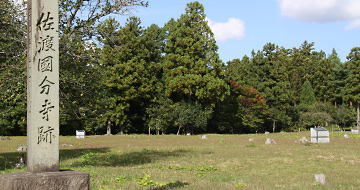 Shrines and Buddhist Temples
Shrines and Buddhist TemplesSado Kokubunji Temple
Sado Kokubunji Temple is one of the provincial temples which were founded in each province on the order of Emperor Shomu. The construction of the temple was completed in 764. Kokubunji Temple was one of the first temples built in Sado, and was a rare example of temples with tiled roofs in the Hokuriku Region. It was burnt down several times after being struck by lightning, as well as catching fire, and then reconstructed. You can see a row of cornerstones from Kondo Main Hall, cloisters, Chumon (middle) Gate, Nandaimon (great south) Gate, a pagoda and Shindo Hall all within the grounds.
Kuninaka area -
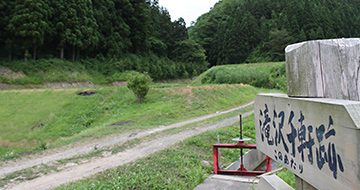 Heritage and Relics
Heritage and RelicsNiibo Ginzan Silver Mine
Situated in Okuyama, which is a releasing point for toki (the Japanese crested ibises), Niibo Ginzan Silver Mine, also known as Takizawa Ginzan Silver Mine, first produced silver around the same time as Tsurushi Ginzan Silver Mine. Although records and a pictorial map from the Edo Period (1603-1867) remain to this day, little is known about this silver mine, including the year of its discovery. Sparsely inhabited today, in the olden days the surrounding area prospered so much that it was called "a town with 1,000 houses." Mining structures, including "Hyakumai Mabu (pit)" and "Ogon Mabu (pit)," still remain.
Kuninaka area -
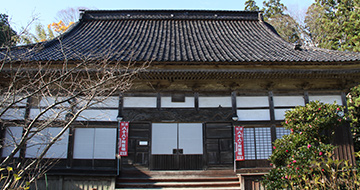 Shrines and Buddhist Temples
Shrines and Buddhist TemplesChoanji Temple
Located in the Kujikawachi village, Choanji Temple is said to have been founded in 831, and has a wooden seated statue of Amitabha and a bronze bell in its storehouse, both of which are designated as Japan's Important Cultural Properties. The statue is said to have been made in the late Heian Period (the 12th century). The bronze bell was pulled up from the bottom of the sea in Wakasa (present-day Fukui Prefecture) around the 13th century, and it is said to have later been dedicated to Choanji Temple. It is one of the forty-seven so-called Korean bells still in existence in Japan, and this is the only one of its kind in Niigata Prefecture. It is 107.5 cm tall and 61.2 cm diameter. The elaborately designed dragon-shaped handle at the top of the bell and the arabesque pattern are striking.
Ryotsu area -
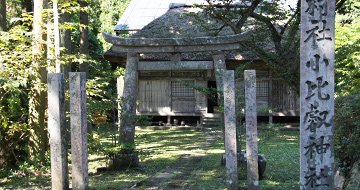 Shrines and Buddhist Temples
Shrines and Buddhist TemplesKobie Shrine
Kobie Shrine used to be a shrine for enshrining the tutelary deity that protected Rengebuji Temple, and was located within the precinct of the temple. It was later separated from the temple, and became a village shrine in the Meiji Period (1868-1912). The stone-built torii gate and main hall, enclosed in an ooiya (a layer of building covering the building inside), are both registered as National Important Cultural Properties. According to the inscription carved on the torii gate, the gate was constructed by Kaiyu, the head priest of Rengebuji Temple, with offerings from Nagayasu Okubo, the Deputy for Sado (later the first Commissioner for Sado) and his brother, Yasumasa Okubo. The thatched worship hall hosts a ritual every February, called "Ta-asobi (rice field work) Shinji," to pray for a good harvest.
Minami Sado area -
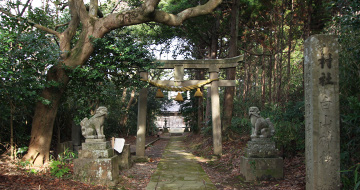 Shrines and Buddhist Temples Noh Stages
Shrines and Buddhist Temples Noh StagesKodomari Hakusan Shrine Noh Stage
Sitting along Route 350, Kodomari Hakusan Shrine features a well-kept precinct and buildings. The shrine is believed to have originated from a small shrine built by a samurai warrior of the Taira clan, who was defeated by the Minamoto clan in the late 12th century. Kodomari flourished as a masonry center along with the adjacent Tsubakio community in the Mano area. Spectacular lion-dog statues welcome visitors to the precinct, which is known for its mound of millstones, where ones that were no longer in use were once collected from households and dedicated to the shrine. Repaired in 2012, a Noh stage stands to the right of the shrine building. The stage is comprised of main and rear stage areas, and is equipped with a chorus area and a "noble passageway" (where nobility could pass without bowing), as well as a space to hang the big temple bell that appears in "Dojoji," one of the great Noh plays. The wall at the back has a painting of a pine tree, and the one on the east side has a painting of bamboo. The passageway connects the stage and the room behind the curtain where actors prepare, and that room is attached to the worship hall. This Noh stage is designated a City Cultural Property.
Minami Sado area -
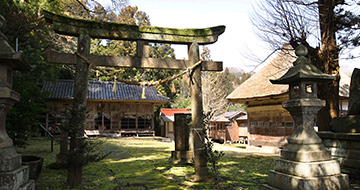 Shrines and Buddhist Temples Noh Stages
Shrines and Buddhist Temples Noh StagesOsaki Hakusan Shrine Noh Stage
The Osaki community is located up the Hamochi River, which runs through the mountains. Here, the tutelary Hakusan Shrine stands side by side with Miyamotodera Temple. The neatly-built stone walls are beautiful, and after passing through the torii gate, the worship hall encased in the protective forest comes into view. This serene place symbolizes the Osaki area, where sophisticated nonmaterial culture is being nurtured. Inhabitants in Osaki hand down various performing arts such as Chobokuri (the phallus dance) and Bunya puppet theatre, and are thought to be particularly enthusiastic about Noh performances compared to others in Sado. Comprised of a main stage area and a rear stage area, the Noh stage within the compound has a thatched hipped roof and a main entrance on the gabled side. The wall at the back has the traditional painting of a pine tree, and there is a space to hang the big temple bell that appears in "Dojoji," one of the great Noh plays. In recognition of its role in handing down Noh culture, as well as the value of its architecture, this stage has been designated a City Cultural Property.
Minami Sado area -
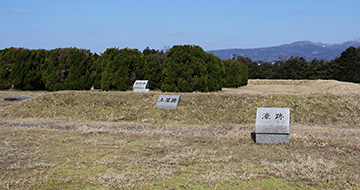 Heritage and Relics
Heritage and RelicsShimoko Site
Shimoko Site (Japan's designated Historical Site) is a square-shaped site of ruins situated around Takedabashi on the Prefectural Route 65, with Osado Mountain Range as its backdrop. The site is encircled by double moats, and two structures with earthfast posts were unearthed there. Many Sueki ware (clay fired at a high temperature), and Hajiki ware (plain, reddish ware), made around the 9th century, were discovered, too. The name "Shimoko (literally means low provincial government)" appears in the Genroku Land Register (1688 - 1704), and it is considered that there used to be buildings similar to government offices or officers' accommodation on the site.
Kuninaka area -
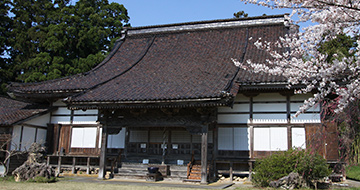 Shrines and Buddhist Temples
Shrines and Buddhist TemplesZenchoji Temple
A walk up the gentle slope, with Akadomari Port in the background, will lead to Zenchoji Temple on the heights, a temple of the Shingon School. It was reputedly founded circa 827. Once every thirty-three years, the main image of the temple, the Shokanzeonbosatsu (Aryavalokitesvara) statue is revealed, which is a lost-wax casting work of the first generation of Rando Miyata. Zenchoji is known as the temporary residence of Tamekane Kyogoku (a court noble) for six years, and in connection with his long-aspired return to Kyoto in 1303, the hidden statue at the upper temple has been worshipped in the name of Kikyo ("coming-home") Kannon. In addition, Mahori Hogan Yoshitaka, a master painter, donated a painting entitled "Kyogoku Bishamonten (Vessavaṇa)". Zenchoji Temple is one of the temples on Sado's Seven Gods of Fortune pilgrimage route. Bishamonten is a god with wisdom and valor, as well as, a god of treasure and happiness, and has been steadfastly worshipped to this day.
Minami Sado area -
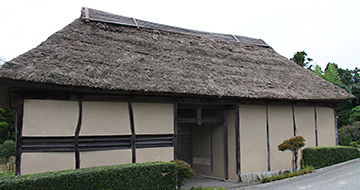 Other
OtherThe Hojo's Residence
This residence is home of the Hojo Family, who started Kampo medical practices in the Edo Period (1603-1867), and passed down the name of "Doeki" from generation to generation. (Kampo is a Chinese traditional herbal medicine.) Past the solid, thatched Nagayamon gate, you can see the main building (a designated National Important Cultural Property) of the residence characterised by a thatched roof and narrow wooden frames. The main building is considered to have been built in the late 18th century. There are also a rice barn, a miso (bean paste) barn and a storehouse for valuable commodities within the spacious grounds surrounded by trees.
Kuninaka area -
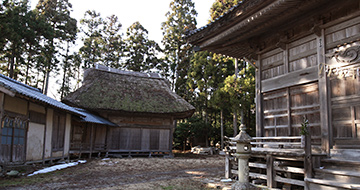 Shrines and Buddhist Temples Noh Stages
Shrines and Buddhist Temples Noh StagesNagae Atsukushihiko Shrine Noh Stage
The shrine's tutelary forest is located in the middle of a vast rice field to the south of Nagae River, and its lion-dog statues standing in the paddy are an impressive scenic feature. Established in the early 9th century, Nagae Atsukushihiko Shrine is one of Sado's nine shrines included in the Engishiki Register. After being moved, the current buildings are said to have been constructed in 1714. This shrine houses the tutelary deity for the Kamo Clan as well as a god of mines that used to be enshrined at Mt. Kinpoku. Within the shrine compound, a Noh stage with a quaint thatched roof stands with its left side facing the main hall. The stage is comprised of a main stage area and a rear stage area, and the passageway connects the stage and the room behind the curtain. Estimated to have been built between 1764–1780, this Noh stage is thought to be a valuable example of few pre-modern structures on Sado, and is designated a City Cultural Property.
Ryotsu area -
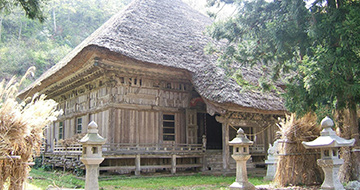 Shrines and Buddhist Temples
Shrines and Buddhist TemplesDainichido
Dainichido is a worship hall in Ohirume Shrine, which is considered to have been established in 1490. The existing building (a Niigata Prefecture's Designated Tangible Cultural Asset) was reputedly reconstructed in 1718. The hall enshrines a statue of Seated Dainichinyorai (Vairocana), considered to be created by Mokujiki Seigen. Seen as a place of worship for a tutelary deity of cows, in the past, cowherds from all over the island traveled on foot with their cows, to pay visits to Dainichido. Many ema (wooden plaques with prayers written down on them) with pictures of cows, and waraji (straw sandals) for cows are dedicated to make wishes come true.
Kuninaka area -
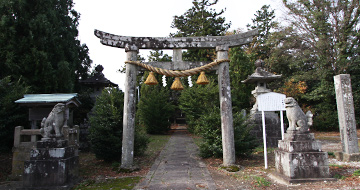 Shrines and Buddhist Temples
Shrines and Buddhist TemplesObuse Shrine
Past the historic Komainu guardian statues, which are considered to have been created by masons in the Tsubakio village, the path opens out onto a vast precinct wooded with oak and Machilus trees. The shrine was reputedly established by the manor lord of Nishimikawa, Honma Yamashiro Nyudo, in the Muromachi Period (1392-1573). The object of worship is the Mikeishi stone enclosed with a stone fence at the back of the main hall. It is regarded as a sacred place where gods descend, and rituals are carried out. Komochimagatama, comma-shaped ornaments with small magatama, are unearthed from the surrounding ground, and Obuse Shrine is highly valued as an ancient site of rituals.
Kuninaka area -
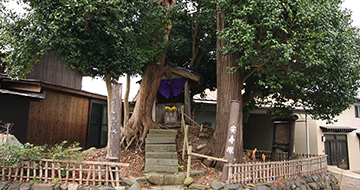 Folklore
FolkloreAnjuzuka (Memorial Mound of Anju in Hatano)
Two different versions of the folk tale "Anju and Zushio" have been passed down from generation to generation in Sado. Hatano is arguably the place where Anju passed away while on her way to Kyoto, after she and her brother had a reunion with their mother. This mound is said to be the burial place of some of her mementos such as her favorite comb. It has been worshipped for good harvests, and for miracles in finding a partner and healing eye diseases. Anju Tenjin Festival takes place every summer.
Kuninaka area -
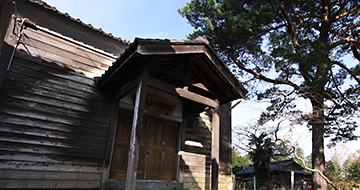 Other
OtherMeiji Kinendo Memorial
Meiji Kinendo was founded by Ryokan Honjo, a Buddhist monk of Tokushoji Temple, to comfort the souls of Sado Islanders who died for their country in the First Sino-Japanese War, and is funded by donations. Later, the souls of the dead in the Russo-Japanese War, Japanese Siberian Intervention, and Manchuria Incident were enshrined here, too. A board inscribed by calligrapher Banko Yoshida with the words of Meiji Kinendo, is hung in front, and the hand-written notes of Field Marshal Iwao Oyama, Katsu Kaishu (a naval officer and mediator in the Meiji Restoration in 1898), and Marshal Admiral Togo are hung inside. A graveyard for Russian navy crews also exists within the grounds.
Kuninaka area -
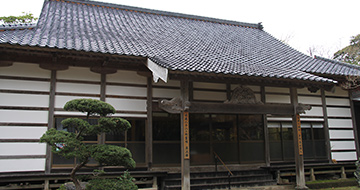 Shrines and Buddhist Temples
Shrines and Buddhist TemplesChikoubo Temple
The historic old temple of Shingon School welcomes you with brilliant sculptures. It is said that the temple was established by Kuzan, a Buddhist monk, in 808, and the main object of worship is a1,000-armed Kannon Bosatsu (Guanyin: Goddes of Mercy). Seen on the sculpture of Sanmon Gate, Ebisu is the god of driving evil spirits away and bringing luck in. It has been greatly worshipped as a god of fishing and safety at sea to this day. The hall enshrining Konpira Gongen, a god of sailors, was founded in 1833 by Jinzaemon Takano, a master carpenter in the Murayama area. You will be overwhelmed by the sculpture, which richly embellishes the hall. Mahori Hogan Yoshitaka, a master artist, donated his painting entitled "Kurasaki Ebisuten" to this temple.
Kuninaka area -
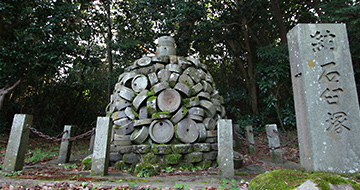 Heritage and Relics
Heritage and RelicsIshiusuzuka (millstones mound)
Kodomari in the Hamochi area prospered from masonry, together with the adjacent Tsubakio area in Mano. Masons in Kodomari also gained a widespread reputation as sculptors of Buddhist stone statues. Millstones used to be one of life's necessities, but with the progress of the times, they slid into obscurity. The mound of millstones was founded by locals to express regret. In 1977, millstones at each household were collected and and then dedicated to Hakusan Shrine in the area.
Minami Sado area